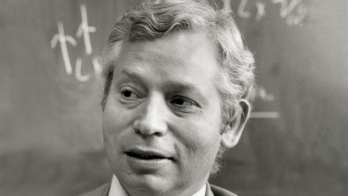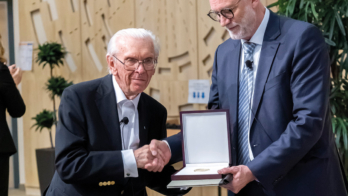
On 16 August 2022, pioneering theorist Harald Fritzsch unexpectedly died at the age of 79. His essential contributions to the development of quantum chromodynamics and the grand unification of the fundamental forces made a lasting and profound impact on the field of theoretical physics.
Harald Fritzsch was born on 10 February 1943 in Zwickau, Germany. He studied physics and completed his diploma thesis at Leipzig University in June 1968. At this time, he had already contemplated leaving the German Democratic Republic (GDR) and so sent his diploma thesis to Werner Heisenberg in Munich. In 1968, in an adventurous and dramatic escape by boat across the Black Sea from the Eastern Block to Turkey, Fritzsch and a friend fled the GDR and relocated to the Federal Republic of Germany. Fritzsch went straight to Munich, where Heisenberg accepted him as a doctoral student in his research group at the Max Planck Institute for Physics. His thesis, supervised by Heinrich Mitter and completed in 1971, dealt with light-cone algebra and the quantisation of the strong interaction. In 1970 Fritzsch received a DAAD scholarship for a six-month stay at SLAC and met Murray Gell-Mann for the first time, in Aspen.
After receiving his doctorate, Fritzsch spent a year as a research fellow at CERN, followed by four years as a senior research associate at Caltech. The collaboration between Fritzsch and Gell-Mann continued and led to groundbreaking work on the strong interaction. In 1977 Fritzsch followed a call as professor at the University of Wuppertal, which changed to become the University of Bern. Then, in 1979, he became Ordinarius at Ludwig Maximilian University in Munich.
In 1971 Fritzsch and Gell-Mann introduced the colour quantum number as the exact symmetry underlying the strong interactions, thereby solving the long-standing problem of preserving the exclusion principle as discussed, for example, by Han and Nambu in 1965. A year later, Fritzsch and Gell-Mann proposed a Yang–Mills gauge theory with local colour symmetry, which is now called quantum chromodynamics (QCD). This new idea was first presented by Gell-Mann in the fall of 1972 at a conference in Chicago, and then in a joint conference paper by Fritzsch and Gell-Mann. In 1973 their famous paper on the colour-octet model of QCD, now also with Heinrich Leutwyler, appeared in Physics Letters. This publication, together with the papers by Gross, Politzer and Wilczek about asymptotic freedom in non-Abelian gauge theories, all published in the same year, is regarded as the beginning of QCD.
Fritzsch wrote many other scientific papers that are of great importance for theoretical particle physics, for example on SO(10) grand-unification, weak interactions, the famous Fritzsch mass matrices and composite models. For his significant scientific achievements, he was awarded the Dirac Medal of the University of New South Wales in Australia in 2008. He was a member of the Society of German
Natural Scientists and Physicians, and of the Berlin–Brandenburg Academy of Sciences. In 2013 he was awarded an honorary doctorate from Leipzig University.
Fritzsch is also widely known as an author of popular scientific books. His book Quarks, published in 1980, was translated into more than 20 languages, and in 1994 he was awarded the Medal for Scientific Journalism of the German Physical Society.
In addition to his outstanding scientific achievements, we also admired Harald for his strong, determined, honest and straightforward mind, and for his courage to express his sound opinions and to tackle problems and disputes, even if inconvenient to some.
Until the very end, Harald was seen in his university office almost every day. He will be sadly missed, but never forgotten.





